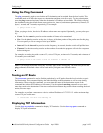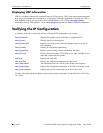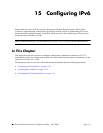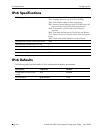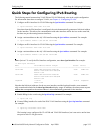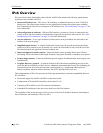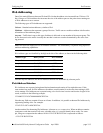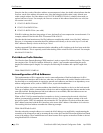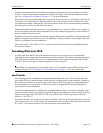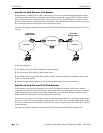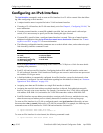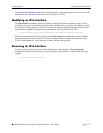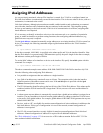
IPv6 Overview Configuring IPv6
page 15-6 OmniSwitch 6600 Family Network Configuration Guide April 2006
Since the last four words of the above address are uncompressed values, the double colon indicates that the
first four words of the address all contain zeros. Note that using the double colon is only allowed once
within a single address. So if the address was1234:531F:0:0:BCD2:F34A:0:0, a double colon could not
replace both sets of zeros. For example, the first two versions of this address shown below are valid, the
last version is not valid:
1 1234:531F::BCD2:F34A:0:0
2 1234:531F:0:0:BCD2:F34A::
3 1234:531F::BCD2:F34A:: (not valid)
With IPv6 addresses that have long strings of zeros, the benefit of zero compression is more dramatic. For
example, address FF00:0:0:0:0:0:4501:32 becomes FF00::4501:32.
Note that hexidecimal notation used for IPv6 addresses resembles that which is used for MAC addresses.
However, it is important to remember that IPv6 addresses still identify a device at the Layer 3 level and
MAC addresses identify a device at the Layer 2 level.
Another supported IPv6 address notation includes embedding an IPv4 address as the four lower-order bits
of the IPv6 address. This is especially useful when dealing with a mixed IPv4/IPv6 network. For example:
0:0:0:0:0:0:212.100.13.6
IPv6 Address Prefix Notation
The Classless Inter-Domain Routing (CIDR) notation is used to express IPv6 address prefixes. This nota-
tion consists of the 128-bit IPv6 address followed by a slash (/) and a number representing the prefix
length (IPv6-address/prefix-length). For example, the following IPv6 address has a prefix length of 64
bits:
FE80::2D0:95FF:FE12:FAB2/64
Autoconfiguration of IPv6 Addresses
This implementation of IPv6 supports the stateless autoconfiguration of link-local addresses for IPv6
VLAN and tunnel interfaces and for devices when they are connected to the switch. Stateless refers to the
fact that little or no configuration is required to generate such addresses and there is no dependency on an
address configuration server, such as a DHCP server, to provide the addresses.
A link-local address is a private unicast address that identifies an interface or device on the local network.
This type of address allows communication with devices and/or neighboring nodes that are attached to the
same physical link. Routing between link-local addresses is not available, link-local addresses are not
known or advertised to the general network.
When an IPv6 VLAN or tunnel interface is created or a device is connected to the switch, a link-local
address is automatically generated for the interface or device. This type of address consists of the well-
known IPv6 prefix FE80::/64 combined with an interface ID. The interface ID is derived from the router
MAC address associated with the IPv6 interface or the source MAC address if the address is for a device.
The resulting link-local address resembles the following example:
FE80::2d0:95ff:fe6b:5ccd/64
Note that when this example address was created, the MAC address was modified by complementing the
second bit of the leftmost byte and by inserting the hex values 0xFF and 0xFE between the third and fourth
octets of the address. These modifications were done because IPv6 requires an interface ID that is derived
using Modified EUI-64 format.




